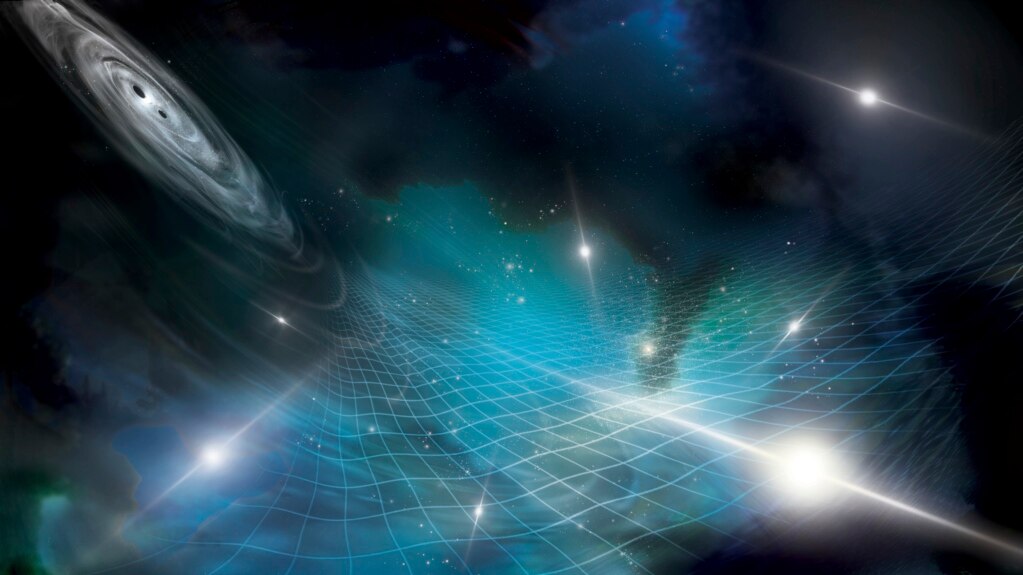Scientists say that, for the first time, they have observed gravitational waves caused by black holes and other huge space objects moving through the universe.
A group of international scientists using radio telescopes in North America, Europe, China, India and Australia made the observation.
The existence of gravitational waves was first predicted more than 100 years ago by physicist Albert Einstein as part of his General Theory of Relativity. Einstein’s theory proposed that gravity is caused by a curving of space and time.
Scientists believe that, as gravitational waves travel through space, they press against and stretch everything they pass through. But researchers have struggled for many years to find solid evidence of the waves. In the 1970s, researchers found indirect proof by studying the motion of two crashing stars. That work was honored as part of the 1993 Nobel Prize in physics.
Then, in 2016, astronomers announced they had detected the first direct evidence of gravitational waves. That evidence came from an American-based research project known as the Laser Interferometer Gravitational-Wave Observatory, or LIGO. The LIGO project used ground-based telescope instruments to detect a gravitational wave produced when two black holes crashed into each other about 1.3 billion light years from Earth.
But the LIGO effort was only able to pick up waves at high frequencies. In the latest research, scientists were attempting to find low-frequency waves as a way to confirm gravitational wave signals.
The researchers said they successfully discovered such signals using about 15 years of data from a project called NANOGrav. This project has long used telescopes across North America to search for low-frequency gravitational waves. The results were recently published in a study in The Astrophysical Journal of Letters.
The research involved scientists aiming a series of radio telescopes at dead stars called pulsars. The pulsars send out radio wave signals as they spin around in space. These signals are so predictable that scientists know exactly when the radio waves are supposed to arrive on Earth. The pulsars are like “a perfectly regular clock ticking away far out in space,” said NANOGrav member Sarah Vigeland. She is an astrophysicist at the University of Wisconsin-Milwaukee.
But gravitational waves can affect the distance between Earth and the pulsars, which can change the signal activity. The researchers examined small changes in the ticking rate across 68 different pulsars. Some signals came early while others came late. The scientists said this research method provided enough evidence that gravitational waves were passing through.
So far, this method has not been able to identify exactly where these low-frequency waves are coming from, said Marc Kamionkowski. He is an astrophysicist at Johns Hopkins University who was not involved with the latest research.
But Kamionkowski told The Associated Press the process does demonstrate how low-frequency gravitational waves appear to produce a continuous background “noise.” He compared the sound to what a person hears when standing in the middle of a party. “You’ll hear all of these people talking, but you won’t hear anything in particular,” Kamionkowski said.
The discovered background noise is “louder” than some scientists had expected, said Chiara Mingarelli. She is a member of the NANOGrav team and an astrophysicist at Yale University. Mingarelli told the AP this could mean there are more, or bigger, incidences of black holes coming together in space than previously thought.
Or it may suggest there could be other sources of gravitational waves that could raise new questions about the formation of the universe. For example, another theory is that gravitational waves could be left over from a fast expansion period that came right after the Big Bang. The Big Bang is the explosion many scientists believe created the universe.
Michael Keith was a member of the research team and works with the European Pulsar Timing Array, a collection of research telescopes. He said the galaxies between Earth and the Big Bang were likely "drowning out" such gravitational waves.
In the future, scientists say low-frequency gravitational waves could provide even more information about early expansion of the universe. In addition, such a study could also help expand research on the mysteries of dark matter.
I’m Bryan Lynn.

